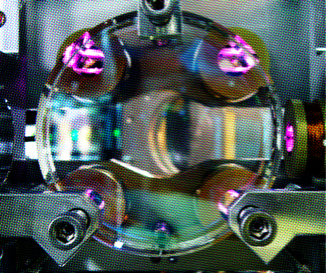
重力波研究交流会
GW research exchange meeting (GWREM)
Upcoming GW-REMs
The 136th REM: Nov. 13rd, 2025
- Time: 16:00-17:00
- Speaker: Daniel Williams (University of Glasgow)
Title: "GWTC-4: Compact Binary Results from the First part of the Fourth LIGO-Virgo-KAGRA Observing Run"
- Abstract:
During the first part of their fourth observing run, the LIGO, Virgo, and KAGRA detectors identified 128 gravitational-wave signals from coalescing compact binary systems, more than doubling the number previously detected through their first three observing runs. I will discuss the new results, and the challenges which we faced and overcame to produce the largest and most intricate set of observations announced by the collaborations so far.
- Abstract:
The past GW REM talks
The 131-140th REM talks
The 135th REM: Oct. 16th, 2025
- Time: 17:00-18:00
- Speaker: Sotatsu Otabe (U Tokyo)
Title: "Kerr-Enhanced Optical Spring for kHz Gravitational Wave Detection"
- Abstract:
Abstract:Gravitational waves in the 2–4 kHz band emitted from binary neutron star post-merger remnants contain critical information about high-density nuclear materials that cannot be accessed by terrestrial experiments. These post-merger signals have not yet been observed and are unlikely to be detected with current gravitational wave detectors due to insufficient sensitivity in kilohertz band. An optical spring with an oscillatory response is a promising route to improve specific band sensitivity in gravitational wave detectors; however, its resonance frequency is limited to approximately 100 Hz in second-generation detectors. To stiffen the optical spring into the kilohertz band and amplify the post-merger signals, it has been proposed to induce nonlinear optical effects in the interferometer to enhance the signal components. In this talk, we present an experimental demonstration of optical spring enhancement via the optical Kerr effect in a Fabry–Perot cavity. We achieve an increase of the effective optical spring constant by a factor of 1.6 ± 0.1 over linear theory. We also outline pathways for implementing the signal amplification system in operational gravitational wave detectors and highlight potential applications in optomechanical systems beyond gravitational wave detector.
- Abstract:
The 134th REM: Aug. 14th, 2025
- Time: 15:00-16:00
- Speaker: Rico Lo (University of Copenhagen, Niels Bohr Institute)
Title: "Gravitational-wave signatures of exotic compact objects"
- Abstract:
While most gravitational-wave signals detected so far are thought to come from black holes, alternatives such as boson stars and gravastars have also been proposed. If sufficiently compact, these exotic objects could produce gravitational waves detectable on Earth, with waveforms distinct from those of black holes. One of the most striking differences is the presence of gravitational-wave echoes—a series of repeating bursts emitted after the object is perturbed, for example in a binary merger. These echoes arise naturally in horizonless ultracompact objects and, if observed, would offer compelling evidence about the true nature of the source. In this talk, I will outline the theoretical foundations of these signatures and review current data analysis efforts to detect them.
- Abstract:
The 133rd REM: Jul. 28th, 2025
- Time: 15:00-16:00
- Speaker: Kazuhiro Yamamoto (U Toyama)
Title: "Coating thermal noise and investigation for reduction"
- Abstract:
Coating thermal noise is one of the fundamental noise sources in interferometric gravitational wave detectors. The reduction of this noise is one of the hottest topics for further detector improvement. However, until the end of the 20th century, nobody expected that a thin coating would contribute thermal noise so largely. Revolutions at the end of the 20th century opened our eyes. I explain what happened around the end of the 20th century and the investigation for coating thermal noise after this revolution. I focus the investigation in Japan, especially, what is going on at Toyama.
- Abstract:
Presentation material, record: https://gwdoc.icrr.u-tokyo.ac.jp/cgi-bin/private/DocDB/ShowDocument?docid=16759 (only for LVK members)
The 132nd REM: Jun. 5th, 2025
- Time: 11:00-12:00
- Speaker: Alvin Li (U Tokyo, RESCEU)
Title: "Gravitational Wave Lensing: Current Status and Future Prospects"
- Abstract:
Gravitational lensing of gravitational waves offers a unique opportunity to probe both astrophysical and cosmological phenomena, from the population properties of compact binaries to the distribution of matter in the Universe. As gravitational waves travel through the Universe, their paths can be deflected, and their amplitudes can be (de)-magnified by intervening massive structures. This leads to various observable signatures, including magnification bias, arrival time delays, and repeated signals. In this talk, I will present an overview of gravitational wave lensing, beginning with the theoretical foundations and the classification of lensing regimes relevant to ground-based detectors. I will review the status of current searches for lensed gravitational wave events, highlighting recent results from the third observing run (O3) of the LIGO-Virgo-KAGRA collaboration. In addition, I will discuss the various methods employed in lensing analyses and the challenges associated with confidently identifying lensed events. I will then outline the prospects for detecting gravitational wave lensing in upcoming observing runs and the potential scientific returns such detections could offer. I will also discuss the specific contributions KAGRA can make in making the first lensed gravitational wave detection.
- Abstract:
The 131st REM: May. 19th, 2025
- Time: 15:00-16:00
- Speaker: Naoki Aritomi (U Tokyo)
Title: "Advanced LIGO detector performance in the fourth observing run"
- Abstract:
I will talk about the LIGO detector performance in O4 based on the recently published paper, Phys. Rev. D 111, 062002 (2025).
- Abstract:
presentation record: https://gwdoc.icrr.u-tokyo.ac.jp/cgi-bin/private/DocDB/ShowDocument?docid=16768 (only for LVK members)
Archives for the past talks
- Most of the archives for the earlier years are written in Japanese (it is a history!).
Useful links
How to receive the announcements
 One has to subscribe to the mailing list called gw_comm in order to receive our announcement emails. Please ask one of our organizers for subscription.
One has to subscribe to the mailing list called gw_comm in order to receive our announcement emails. Please ask one of our organizers for subscription. The organizers can be found in this page.
